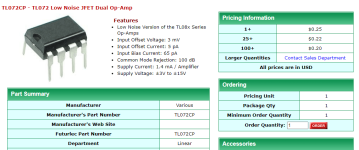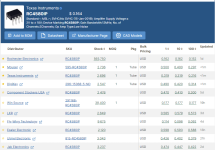I need a standard pinout dual 8pin DIP OPAMP that can reproduce a 100khz square wave at 2.5vpp with reasonable fidelity. An LM318 would be a good choice but it's a single package only. My application is a distribution amplifier. Using the 5x rule of thumb, the OPAMP should go out to 500mhz at -3db. Gain is unity using +/- 12v rails.
This is not a quality audio application. The signal is called Time Code and is normally a 1200hz/2400hz data stream that represents time as hrs/min/sec/frames. Quite common in the recording and broadcast industry. It was designed to be recorded on standard analog audio tracks or better yet optimized electronics for high frequency. As the signal is Manchester encoded, as long as the zero crossings can be detected, it will read properly. So again a perfect square wave is not necessary.
The problem is fast forward and rewind. You want to maintain the count and when in rew or ff, the frequency can climb to 100khz. Note that some vintage analog studio tape machines have a specific channel option to be able to read 100khz but in this mode the track are not suitable for audio as it has pulse regeneration circuitry switched in.
TIA
This is not a quality audio application. The signal is called Time Code and is normally a 1200hz/2400hz data stream that represents time as hrs/min/sec/frames. Quite common in the recording and broadcast industry. It was designed to be recorded on standard analog audio tracks or better yet optimized electronics for high frequency. As the signal is Manchester encoded, as long as the zero crossings can be detected, it will read properly. So again a perfect square wave is not necessary.
The problem is fast forward and rewind. You want to maintain the count and when in rew or ff, the frequency can climb to 100khz. Note that some vintage analog studio tape machines have a specific channel option to be able to read 100khz but in this mode the track are not suitable for audio as it has pulse regeneration circuitry switched in.
TIA
I don't understand where that 500 millihertz comes from, 5 times 100 kHz is neither 500 mHz nor 500 MHz.
If you allow a 1 µs transition time, 5 V/µs is the bare minimum required slew rate. It sounds to me like a TL072 should do, if it can handle the unspecified load. An NE5532 is also fast enough and better at driving relatively low impedance loads, but the antiparallel diodes between its inputs might be a problem.
If you allow a 1 µs transition time, 5 V/µs is the bare minimum required slew rate. It sounds to me like a TL072 should do, if it can handle the unspecified load. An NE5532 is also fast enough and better at driving relatively low impedance loads, but the antiparallel diodes between its inputs might be a problem.
Unity gain, square wave in, square wave out, amplitude = 0.10 * supply rail deltaV . . . .
Sounds like a job for an emitter coupled logic gate! You'll get 15 nanosecond risetimes and falltimes (5% - 95%), no overshoot, tremendously good load capacitance driving, and (if you want it) fully differential outputs. Square waves without significant voltage gain are the natural stomping ground of digital circuits.
Think of it as a 1-bit Analog-To-Digital Converter. In other words, an incredibly fast voltage comparator with not much gain.
Sounds like a job for an emitter coupled logic gate! You'll get 15 nanosecond risetimes and falltimes (5% - 95%), no overshoot, tremendously good load capacitance driving, and (if you want it) fully differential outputs. Square waves without significant voltage gain are the natural stomping ground of digital circuits.
Think of it as a 1-bit Analog-To-Digital Converter. In other words, an incredibly fast voltage comparator with not much gain.
Typo on my part! And I have always used MHZ, Mhz, mhz, interchangeably. I don;t have any experience with millihertz but I see your point.I don't understand where that 500 millihertz comes from, 5 times 100 kHz is neither 500 mHz nor 500 MHz.
If you allow a 1 µs transition time, 5 V/µs is the bare minimum required slew rate. It sounds to me like a TL072 should do, if it can handle the unspecified load. An NE5532 is also fast enough and better at driving relatively low impedance loads, but the antiparallel diodes between its inputs might be a problem.
ECL ? A bit overkill IMO. I have a background in high speed digital for imaging and video so I have used it. I could also use video OPAMPs but those would be overkill too and expensive.Unity gain, square wave in, square wave out, amplitude = 0.10 * supply rail deltaV . . . .
Sounds like a job for an emitter coupled logic gate! You'll get 15 nanosecond risetimes and falltimes (5% - 95%), no overshoot, tremendously good load capacitance driving, and (if you want it) fully differential outputs. Square waves without significant voltage gain are the natural stomping ground of digital circuits.
Think of it as a 1-bit Analog-To-Digital Converter. In other words, an incredibly fast voltage comparator with not much gain.
I really need a standard dual 8pin DIP package and I realize DIP packages are becoming obsolete more and more. I guess I could use SMD to DIP adapter boards.
If the RC4580 (12 MHz / dual / PDIP8 / $0.09@100pcs) is too expensive, you could do the job with three 2N3904/6 discretes and some resistors. Their fTs are guaranteed 300 megahertz, and their saturated switching delays are waaaaay quicker than what is required for 0.1 MHz clock and data rates. Instead of building a nonsaturated (ECL) logic gate, turn back the clock to 1962 and build a boring old saturated (RTL) logic gate using today's thru hole jellybean transistors.
You say it is not a quality audio thing but in fact, it is. LTCI need a standard pinout dual 8pin DIP OPAMP that can reproduce a 100khz square wave at 2.5vpp with reasonable fidelity. An LM318 would be a good choice but it's a single package only. My application is a distribution amplifier. Using the 5x rule of thumb, the OPAMP should go out to 500mhz at -3db. Gain is unity using +/- 12v rails.
This is not a quality audio application. The signal is called Time Code and is normally a 1200hz/2400hz data stream that represents time as hrs/min/sec/frames. Quite common in the recording and broadcast industry. It was designed to be recorded on standard analog audio tracks or better yet optimized electronics for high frequency. As the signal is Manchester encoded, as long as the zero crossings can be detected, it will read properly. So again a perfect square wave is not necessary.
The problem is fast forward and rewind. You want to maintain the count and when in rew or ff, the frequency can climb to 100khz. Note that some vintage analog studio tape machines have a specific channel option to be able to read 100khz but in this mode the track are not suitable for audio as it has pulse regeneration circuitry switched in.
TIA
is recorded on a linear track and is handled exactly like the
analog audio same DAs, routing switchers. LTC has the
numbers of the frames in each frame so even if you miss
one in shuttle it's not an issue. Any opamp with more speed
than a 741 will do fine - even the 741 with a little care will
do fine. Don't overthink this.
G²
I think this comes down to not having the basics of S.I. taught at school? Everything in S.I. is case-sensitive and there are simple rules that (most) things follow to make it easy to remember.Typo on my part! And I have always used MHZ, Mhz, mhz, interchangeably. I don;t have any experience with millihertz but I see your point.
For multipliers greater than x1000 (k), all the symbols are upper case (M,G,T,P,E...) for fractional multipliers, lower case (d,c,m,µ,n,p,f,a,...)
The physical unit symbols named after a person are always capitalized, So A,V,H,F,K,Hz,S,N,J,Pa etc, others are lower case, s,m,g,lm, etc. The ohm symbol I couldn't find on my keyboard, but its an upper case greek omega, so it follows the rule too.
The full name of a unit named after a persion is always lower case to distinquish from the actual person, so the ohm is named after Georg Ohm, for instance, the joule named after James Prescott Joule, etc etc. The unit names don't take a plural, so its "5 ohm", "2 henry" etc, but everyone breaks that in informal speech(!)
So megahertz is always MHz, millihertz is mHz. There, you can't forget now!
One issue with LTSpice is that its case insensitive so has the same problem with m and M, which is why you have to say 1Meg for a 1Mohm resistor. This catches me out less often these days...
Just train your fingers to type E+6 . Everybody recognizes that as million. Even Laurence Nagel (SPICE2). Even Mike Engelhardt (LTSPICE).
You might try a fairly new opamp from T.I. ---the TLV9362. It has excellent slew rate---25v/uSec, and 10MHz bandwidth. It's also pretty cheap---at ~$1.34 each.
I looked up the TL072 recently and TI conveniently directed me to the "new and improved" TL072H - slew rate 20V/uS and looks about the same price.
https://www.ti.com/product/TL072H
https://www.ti.com/product/TL072H
- Home
- Source & Line
- Analog Line Level
- Need OPAMP advice (low cost)

